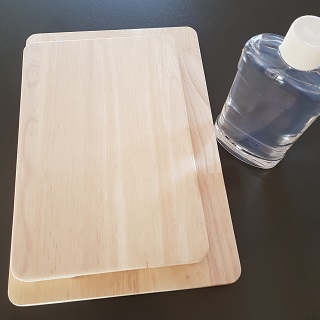Hi,
we recently bought two wooden chopping boards. I really really prefer those to plastic ones. For couple of reasons. One is that they are nature friendly – if you lose one on picnic it will only decompose after some time, and the mushrooms and wild life will love them. Second reason is that they look nice, much better then the plastic and if they get a scratch you can easily sand it down and make them nice and smooth once more. Not something you can do with plastic.
Welcoming wooden chopping boards
In order for your boards to last longer and to not pick up any smells, it’s important to have a bit of patience. This part may seem like a major bother, but it will reward you with long life of your wooden chopping boards. First thing to do after you come with your new boards home is to oil them. This may seam like an information that we all know, but even my Mum is not doing it to her new boards. Usually we forget to do that. We’re in a hurry and we want to chop something. Or we simply put the new boards directly to their new spot and say we’ll oil them later. But it really is an important thing to do, and you should not delay it.
Oils for the boards
For oiling wooden boards I use either sesame oil or mineral oil for wooden boards. Sesame oil that I would use is not the sesame oil used for cooking in wok. It has no spices nor smell, it is cold pressed sesame oil, you can use for salads. It has a vague smell of sesame. But it’s not really noticeable. This oil has natural preservatives and prevents the board for taking on any smells. The only problem with sesame oil is that it is more easily removed from the board and needs more replenishing than the mineral oil. Advantage is that you would eat it anyway, so no extra caution is needed.
Mineral oil for boards is a longer lasting option. It will take more time between the replenishing, but some caution is needed when applying it. And I wash the boards after they have soaked up all of the mineral oil, because even though it is special mineral oil of cutting boards, you should still not ingest it.
Oiling of boards
To oil the wooden boards, apply a small amount of oil to the board and spread it around using a paper towel or kitchen towel. If working with mineral oil I prefer to use paper towels cause even when using kitchen towels you have to discard them after the application.
When you have thoroughly oiled one side, oil the other side as well and the sides of the boards. Don’t be stingy with the oil. Let the board soak up as much oil as possible. Then let the boards rest for 24 hrs before applying second layer. After the second layer of the oil has had 24 hrs to soak up, lightly wash the boards of excess mineral oil, or remove the excess sesame oil using paper towel.
Maintenance of the wooden chopping boards
To keep your boards happy and good looking for a long long time, there is some maintenance required. Once a month make sure to wash them thoroughly, then I rub my boards with half a lemon or lime and let it rest for a couple of minutes. If you don’t have any lemons, you can use white wine vinegar. This will sanitize your boards – 9% proof vinegar will kill 80-90% of all bacteria. Which is perfect. After rubbing them with lemon or vinegar, let them dry out a bit, then wash them again. If you have big scratches on board you can now sand them down, and wash them again. Let them completely dry out.
If you still can smell something on your board (onion smell is hard to remove), cover it with a thin layer of baking soda as it dries. This will further bind smells and sanitize them some more. Then when they are dry wipe the soda off.
Next step is to reapply the oil. Again first apply generous amount of oil and let it soak completely. If needed, you can apply the second layer of oil. Remove the residue by a quick wash, or by rubbing it with clean paper towel.
This process makes sure your board look their best, and don’t have any weird smells. I still suggest having a plastic cutting board for meats, since meat bacteria are hard to get rid off. Wood can still soak up a bit of the meat juice and then the bacterial growth on the wooden board explodes. So cut your meats on plastic, for bread, hard cheese and veggies use wooden chopping boards.

